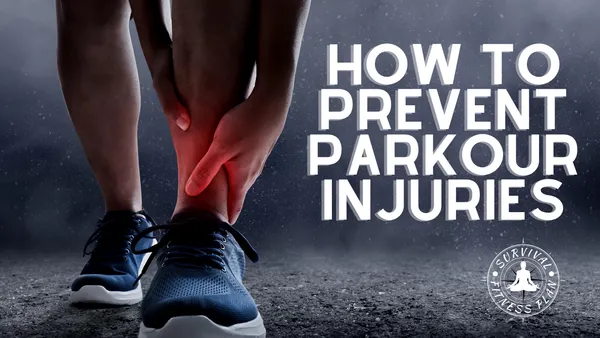Table of Contents
Parkour is a physically demanding activity that can lead to injuries. If you're interested in trying parkour, it's important to understand the risks involved and how to prevent them. At Kizworld, we're passionate about helping people stay safe while enjoying parkour. In this article, we'll discuss The most common parkour injuries and how to prevent them.
The Most Common Parkour Injuries and How to Prevent Them
I. The Most Common Parkour Injuries
The Most Common Parkour Injuries
Ankle Sprains
- Ankle sprains are one of the most common parkour injuries.
- They can occur when you land awkwardly from a jump or when you step on an uneven surface.
- Symptoms of an ankle sprain include pain, swelling, and bruising.
- Treatment for an ankle sprain typically involves rest, ice, compression, and elevation (RICE).
- In some cases, surgery may be necessary.
How to Choose the Right Parkour Shoes and Gloves
Knee Injuries
- Knee injuries are another common parkour injury.
- They can occur when you land awkwardly from a jump or when you collide with an obstacle.
- Symptoms of a knee injury can include pain, swelling, and stiffness.
- Treatment for a knee injury typically involves rest, ice, compression, and elevation (RICE).
- In some cases, surgery may be necessary.
The Best Parkour Mats and Blocks
Shoulder Injuries
- Shoulder injuries are also common in parkour.
- They can occur when you land awkwardly from a jump or when you collide with an obstacle.
- Symptoms of a shoulder injury can include pain, swelling, and stiffness.
- Treatment for a shoulder injury typically involves rest, ice, compression, and elevation (RICE).
- In some cases, surgery may be necessary.
The Best Parkour Equipment and Gear
Wrist Injuries
- Wrist injuries are another common parkour injury.
- They can occur when you land awkwardly from a jump or when you collide with an obstacle.
- Symptoms of a wrist injury can include pain, swelling, and bruising.
- Treatment for a wrist injury typically involves rest, ice, compression, and elevation (RICE).
- In some cases, surgery may be necessary.
The Most Common Parkour Mistakes and How to Fix Them
Head and Neck Injuries
- Head and neck injuries are the most serious type of parkour injury.
- They can occur when you land awkwardly from a jump or when you collide with an obstacle.
- Symptoms of a head or neck injury can include headache, nausea, vomiting, and loss of consciousness.
- Treatment for a head or neck injury typically involves immediate medical attention.
- In some cases, surgery may be necessary.
The Best Parkour Exercises and Drills
II. How to Prevent Parkour Injuries
How to Prevent Parkour Injuries
Warm Up Properly
Warming up before you start parkour is essential to prevent injuries. A warm-up helps to increase your heart rate and blood flow, which prepares your muscles for activity. It also helps to improve your flexibility and range of motion, which can help to prevent strains and sprains. There are many different ways to warm up, but some common exercises include jogging, jumping jacks, and dynamic stretches.
Use Proper Technique
Using proper technique is another important way to prevent parkour injuries. This means learning the correct way to perform each move and practicing it until you can do it safely and consistently. There are many resources available to help you learn proper technique, such as books, DVDs, and online tutorials. You can also take classes from a qualified parkour instructor.
Condition Your Body
Conditioning your body is also important for preventing parkour injuries. This means building up your strength, endurance, and flexibility. You can do this by doing regular exercise, such as running, swimming, and weightlifting. You can also do specific exercises to improve your parkour skills, such as plyometrics and agility drills.
Know Your Limits
It is important to know your limits and not push yourself too hard. If you are new to parkour, start with easy moves and gradually work your way up to more difficult ones. Don't try to do moves that you are not ready for, as this can lead to injury. It is also important to listen to your body and take breaks when you need them.
- Most Common Gymnastics Injuries and How to Prevent Them
- Difference Between Artistic, Rhythmic, and Acrobatic Gymnastics
Use Safety Equipment
Using safety equipment can also help to prevent parkour injuries. This includes wearing a helmet, knee pads, and elbow pads. You should also make sure that you are practicing in a safe environment, such as a parkour gym or a designated parkour area.
III. Tips for Safe Parkour Training
Tips for Safe Parkour Training
Parkour is a physically demanding activity that can lead to injuries. To stay safe while parkouring, it is important to follow these tips:
- Choose a safe location. Parkour should be practiced in a safe environment, such as a park or gym. Avoid practicing in areas with uneven surfaces, obstacles, or traffic.
- Train with a qualified instructor. A qualified instructor can teach you the proper techniques and help you avoid injuries.
- Be aware of your surroundings. Pay attention to your surroundings and be aware of any potential hazards, such as obstacles, people, or animals.
- Don't push yourself too hard. Start slowly and gradually increase the difficulty of your training as you get stronger and more experienced.
- Listen to your body. If you feel pain, stop and rest. Don't push yourself through pain, as this could lead to a serious injury.
By following these tips, you can help to reduce your risk of injury and enjoy parkour safely.
Before You Start | During Your Training | After Your Training |
Choose a safe location | Be aware of your surroundings | Stretch and cool down |
Train with a qualified instructor | Don't push yourself too hard | Listen to your body |
Be aware of your surroundings | Use proper technique | Stay hydrated |
Related Posts:
- The Most Common Parkour Injuries and How to Prevent Them
- How to Do a Handstand
- The Benefits of Gymnastics for Kids
IV. When to Seek Medical Attention for Parkour Injuries
When to Seek Medical Attention for Parkour Injuries
Parkour is a physically demanding activity that can lead to injuries. While most parkour injuries are minor and can be treated at home, some injuries may require medical attention. If you experience any of the following symptoms, you should seek medical attention immediately:
- Severe pain that does not go away with rest
- Swelling or bruising that does not go away with ice and compression
- Deformity or instability of a joint
- Loss of sensation or movement in a limb
- Headache, nausea, or vomiting
- Blurred vision or double vision
- Loss of consciousness
If you are unsure whether or not your injury requires medical attention, it is always best to err on the side of caution and seek medical attention. Early diagnosis and treatment can help to prevent serious complications.
In addition to the symptoms listed above, you should also seek medical attention if you have a chronic injury that is not improving with home treatment. Chronic injuries can lead to long-term pain and disability. A doctor can help you to develop a treatment plan that will help you to manage your pain and improve your function.
If you are injured while parkouring, it is important to seek medical attention as soon as possible. Early diagnosis and treatment can help to prevent serious complications and ensure a full recovery.
Injury | Symptoms | Treatment |
Ankle sprains | Pain, swelling, and bruising around the ankle | RICE (rest, ice, compression, elevation) |
Knee injuries | Pain, swelling, and stiffness in the knee | RICE, physical therapy, surgery |
Shoulder injuries | Pain, swelling, and stiffness in the shoulder | RICE, physical therapy, surgery |
Wrist injuries | Pain, swelling, and bruising around the wrist | RICE, physical therapy, surgery |
Head and neck injuries | Headache, nausea, vomiting, blurred vision, double vision, loss of consciousness | Immediate medical attention |
By following these tips, you can help to reduce your risk of injury and enjoy parkour safely.
Here are some additional tips for staying safe while parkouring:
- Choose a safe location to practice parkour.
- Train with a qualified instructor.
- Be aware of your surroundings.
- Don't push yourself too hard.
- Listen to your body.
By following these tips, you can help to reduce your risk of injury and enjoy parkour safely.
If you are interested in learning more about parkour, there are many resources available online and in libraries. You can also find parkour classes and workshops in many cities.
Parkour is a challenging and rewarding activity that can be enjoyed by people of all ages and fitness levels. By following these tips, you can help to reduce your risk of injury and enjoy parkour safely.
The Most Common Gymnastics Injuries and How to Prevent ThemThe Most Common Martial Arts Injuries and How to Treat ThemThe Most Common Surfing Injuries and How to Avoid ThemThe Most Common Calisthenics Mistakes and How to Fix ThemThe Most Common Parkour Injuries and How to Avoid ThemThe Most Common Snowboarding Injuries and How to Avoid ThemThe Most Common Running Injuries and How to Prevent ThemThe Most Common Kickboxing Injuries and How to Avoid ThemThe Most Common Boxing Injuries and How to Prevent ThemThe Most Common Skateboarding Injuries and How to Avoid Them
V. Conclusion
Parkour is a physically demanding activity that can lead to injuries, but by following the tips in this article, you can help to reduce your risk of injury and enjoy parkour safely. Always warm up properly, use proper technique, condition your body, know your limits, and use safety equipment. If you do get injured, seek medical attention immediately and follow your doctor's instructions for treatment and rehabilitation. With proper care and attention, you can recover from a parkour injury and get back to enjoying the sport you love.